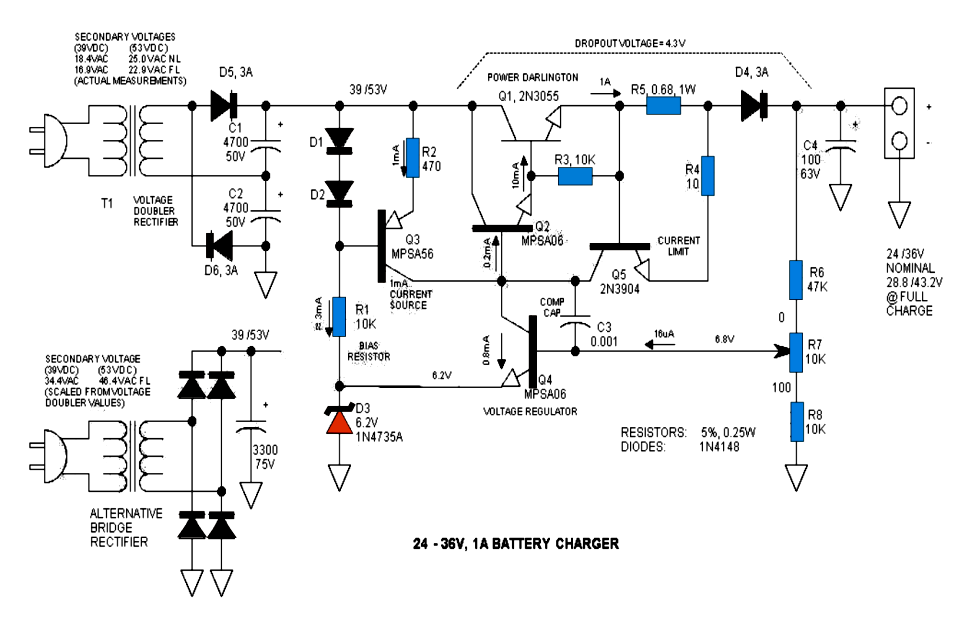Although this is a classic circuit method, it can be maximized for recharging considerably higher voltage lead-acid battery packs, as well as could be utilized on other forms of batteries as well. By appropriate transformer choice, it is usually designed for possibly 24 or 36V. Keep in mind that genuine float charge voltage demands 2.4V /cell or 28.8 & 43.2V @ full charge respectively.
Battery Charger Circuit Information
Q1 & Q2 constitute a power Darlington employing the venerable 2N3055 power transistor. The base of the Darlington is managed by Q4, the voltage regulator transistor—it examines the feedback voltage originating from the voltage scaling pot with the 6.2V zener reference associated in the emitter circuit. C3 is a countervalue capacitor that decelerates the regulator to be able to ward off possible oscillation.
Rather than a pull-up resistor to switch the Darlington on, Q3 is set up as a 1mA current source. Holding a job into a current reference, Q4 dissipates significantly less power, raises optimum voltage employed on the Darlington and raises voltage regulator gain. High voltage (80V) transistors are crucial with this usage and the MPSA06 and A56 are recommended.
R5 and Q5 constitute the current regulator. While the voltage across R5 surpasses about 0.65V, Q5 becomes on and shunts base drive from the power Darlington consequently leading to the output voltage to be decreased. My battery charger circuit ran at 1.1A.
There are a couple of modes of operation—voltage regulation or current regulation—the current regulator (while in business) needs precedence over the voltage regulator.
Thermal administration
I utilized a puny 5.8°C/W heatsink and although it concentrated on the bench Fine, a considerably bigger extruded heatsink. Let me allow you to choose your individual; I could not find an extrusion at DigiKey which was drilled for the TO3 package, which means you might have to drill your very own heatsink for the 2N3055 transistor. The battery charger circuit possesses short-circuit shield, however this could be temporary at the most as the transistor becomes sizzling hot. I inadvertently shorted the output and indeed, the current continued to be at 1.1A.
Circuit Diagram
Transformer preference
Answer to this venture is the transformer choice. I began with a classic multi-tap Stancor rectifier transformer conservatively evaluated at 100VA. Even though this furnished the proper DC voltage, I selected to utilize an attainable 24V transformer which is a bit more standard of what the rest could possess. Keep in mind the transformer is undoubtedly the most valuable device if literally bought. The BOM implies an appropriate 24V transformer sold at DigiKey. DigiKey does not possess a reasonable 48V transformer.
To application the 24V transformer, a voltage doubler rectifier is needed to acquire the organic 53V supply. Each varieties of rectifiers are mentioned on the battery charger schematic.
Word: to maintain the series regulator from being forced to disperse an extravagant degree of power, the organic DC voltage ought to be around 10V more compared to the optimum output voltage. Drop-out voltage is 4.3V—if the organic voltage actually declines below this amount, the output goes down away from control.
Kuberkoos, who recommended this project, is going to be utilising several transformer secondaries (and/or inadequate secondaries) associated in series to acquire the needed voltage—this furthermore is an adequate approach.
Getting it up and running
There exists significantly detrimental power with this one therefore it is advisable to take the voltage up progressively via a variable DC power supply or Variac operating the transformer primary. I am pleased I essentially followed it in this fashion since I had fitting faults that turned up before leading to fumes.
What to keep your eyes open for
While charging a reduced battery, the regulator will continue in current control along with the voltage is going to be reduced until the float charge voltage is attained. Here, the current is going to decline.













0 comments:
Post a Comment